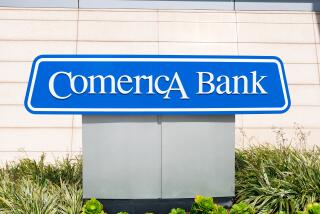FDIC: Banks May Have Worst Year Since 1934
- Share via
WASHINGTON — The nation’s banks earned a record $5.8 billion last summer but still may end the year with the lowest overall earnings since 1934, the government’s Federal Deposit Insurance Corp. said Monday.
FDIC Chairman L. William Seidman blamed the prognosis on continued economic problems in Texas and other oil-industry states, combined with large writeoffs taken in the April-June quarter to cover Latin American loan losses.
Separately, the Federal Home Loan Bank Board said 10% of the nation’s approximately 3,000 savings and loan institutions are now insolvent, with about one-third of these insolvencies occuring in Texas alone.
The nation’s savings and loans lost $1.6 billion in the July-September quarter, a slight improvement from the previous quarter, the regulatory agency said.
Meanwhile, commercial bank failures this year have already climbed to a record 173, and may reach 200 by year’s end, Seidman said.
He said nine banks failed last week alone, the record for a one-week period. There were 144 bank failures last year.
Seidman said the number of bank failures would narrow next year, but not by as much as originally expected--largely because of continued bank failures in the Southwest.
“Clearly, the economy in the Southwest is not improving,” he told a news conference. “Right now, we do not see any recovery in the figures. Oil prices have gone down and there’s great uncertainty on where they will go in the future.”
Higher Rates Helped
FDIC said the rebound in profits in the third quarter followed a record loss of $10.6 billion in the second quarter.
“Banking profits are on a roller coaster this year,” Seidman said.
He said the upswing was due in part to higher interest rates, which boosted yields to banks on loans and investment securities, and in part because major banks put fewer dollars into reserves during the period.
The large sums put in reserve in the second quarter as a hedge against anticipated later losses on Latin American loans “substantially reduced the the need for these banks to add to reserves during the third quarter,” FDIC said.
Despite the continued bleak outlook for the Southwest, the overall profitability of small banks, particularly in the Midwest, has been improving this year in a reflection of a better farm economy.
Also, the October stock market plunge “has resulted in an increase in bank deposits,” FDIC said. It did not specify to what extent.
In response to questions, Seidman said it is still too early to tell what overall impact the stock market collapse will have on the banking system.
Biggest Losses in Texas
In a separate report Monday, the Federal Home Loan Bank Board said the 3,178 savings and loan institutions it insures suffered net losses in the third quarter of $1.6 billion, compared to losses of $1.8 billion in the second quarter.
The board said 934 S&Ls; lost a total of $3.1 billion in the third quarter. Of this group, 318 were insolvent and posted net losses of $2.3 billion.
Insolvent Texas S&Ls; accounted for 61% of the losses.
“The impact of Texas on industry earnings underscores the urgency the bank board attaches to completing a study now under way to deal with the troubled (savings and loans) in that state,” said James R. Barth, the board’s chief economist.
With the insolvent S&Ls; subtracted from the totals, the industry showed net earnings of $713 million in the third quarter, compared to second-quarter earnings of $582 million.
The bank board has closed or otherwise liquidated 28 insolvent S&Ls; and plans to take similar action against 16 more before the end of the year, Barth said.
He said the board plans to close an average of one insolvent savings and loan a week in 1988.
More to Read
Sign up for Essential California
The most important California stories and recommendations in your inbox every morning.
You may occasionally receive promotional content from the Los Angeles Times.













